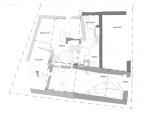Summary (English)
The ninth excavation campaign in Siponto Archaeological Park took place between 29th August and 7th October 2011. The aim was to continue investigating the perimeter of the large building identified in 2009 in the southern part of the town.
The building had a pseudo-trapezoidal plan covering an area of about 525 m2 (21 × 25 m), with a well-organised division of the internal spaces. At present at least seven rooms are known, of which two of substantial size on the eastern side and southern sides (respectively 80 m2 and 110 m2).
The building had been subjected to heavy and accurate robbing which appeared planned. Therefore, the structures were only visible in negative or at foundation level, and it was very difficult to make a clear interpretation of the stratigraphy. The walls showed various construction techniques, indicating diverse building phases and restructuring.
The building had an interesting rainwater collection system, constituted by drains underlying the floor surface (well-preserved in the large room on the south side) and by two cisterns of different sizes, partially filled with small cobblestones, perhaps to aid drainage. The water supply was also guaranteed by a well built into the south perimeter wall during the building’s construction. This cylindrical structure was built of large blocks arranged in regular courses, shaped to form a circular perimeter (diam. 0.50 m).
Interesting architectural and sculptural elements, pottery, and glass finds came from the destruction layer, giving a date of the full 13th century, which a preliminary study suggests relate to the Mediterranean cultural koiné and high social status.
Director
- Caterina Laganara Fabiano - Università degli Studi di Bari, Dipartimento di Beni Culturali e Scienze del Linguaggio
Team
- Comasia Petronella - Università degli Studi di Bari A. Moro, Cattedra di Archeologia Medievale
- Enrica Zambetta - Università degli Studi di Bari A. Moro, Cattedra di Archeologia Medievale
- Patrizia Albrizio - Università degli Studi di Bari A. Moro, Cattedra di Archeologia Medievale
- Raffella Palombella - Università degli Studi di Bari A. Moro, Cattedra di Archeologia Medievale
- Austacio Busto - Università degli Studi di Bari A. Moro, Cattedra di Archeologia Medievale
Research Body
- Università degli Studi di Bari
Funding Body
- Fondazione Cassa di Risparmio di Puglia






![Download [PDF]](/excavation/skins/fasti/images/results/download_sml.png)
